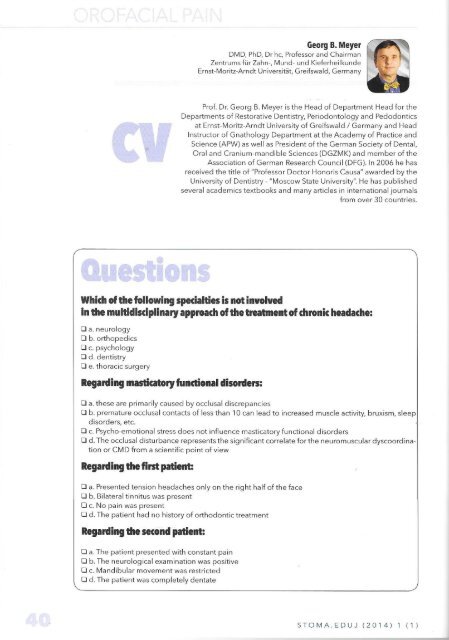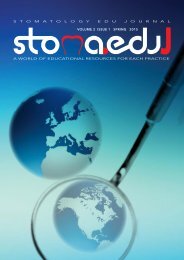Stomatology Edu Journal 1/2014
You also want an ePaper? Increase the reach of your titles
YUMPU automatically turns print PDFs into web optimized ePapers that Google loves.
orofacial pain<br />
Table 1. Extra - and intra-oral findings<br />
The following extra-oral findings<br />
were recorded:<br />
- mandibular mobility, i.e., opening, protrusion,<br />
and lateral movements unrestricted<br />
and normal;<br />
- palpation pain in both TMJs;<br />
- pressure sensitive musculature in right anterior<br />
Temporalis, left Masseter, right shoulder muscles;<br />
- hypersensitive nerve exit points in left infraorbital<br />
area, right mandible.<br />
The following intra-oral findings were<br />
recorded (Figs 5 to 7):<br />
- complete, well-maintained dentition without<br />
wisdom teeth;<br />
- partial crowns on 16 and 26, gold, with compo site<br />
fillings on 17,14, 24, 25, 27, 37, 36, 46, and 47;<br />
- suspected dentin fracture in tooth 17;<br />
- bilateral tongue impressions;<br />
- anterior open bite from/to premolars bilaterally;<br />
- premature contacts 17/47 in physiological<br />
centric position/cotton-roll test centric.<br />
Pathology<br />
Masticatory functional disorders are primarily<br />
caused by occlusal discrepancies when these<br />
are noticeably above or below the 10- to 20-<br />
µm range of desmodontal tactility (18). In<br />
experimental examinations, Kobayashi and<br />
Hansson (19) found that premature occlusal<br />
contacts of a magnitude of 100 µm on fillings,<br />
i.e., 10 times the desmodontal tactility, can<br />
contribute to increased muscle activity, bruxism,<br />
sleep disorders, increased adrenaline excretion,<br />
sleep apnea, TMJ complaints etc. An essential,<br />
even decisive exacerbating factor is psychoemotional<br />
stress (“grinding your teeth”); thus,<br />
the initial dental diagnostics must pay particular<br />
attention to such symptoms (5,10,11,20). The<br />
same is true of primarily orthopedic problems<br />
which can have an immediate interaction with<br />
CMD (17,21).<br />
From a scientific point of view, it is not primarily<br />
the occlusal disturbance but rather the hyperactive,<br />
pressure-sensitive masticatory and craniofacial<br />
muscles which are a significant correlate for<br />
the neuromuscular dyscoordination or CMD<br />
(Fig. 3). But the grosser occlusal interferences<br />
are, the higher is their risk potential for causing<br />
CMD (22). Therapeutically, every treatment that<br />
leads to muscle relaxation or re-coordination<br />
of the neuromuscular system makes sense, for<br />
instance, treatment with a dental (relaxation) splint<br />
(23,24), information consulting, self-observation,<br />
physiotherapy, medication, psychotherapy, and<br />
other forms of treatment (5,15,20,25,26).<br />
Figure 5-7. Open bite despite orthodontic<br />
treatment, with support exclusively on the molars,<br />
which could explain the pain in these areas<br />
Patient examination<br />
As part of the interdisciplinary diagnostics of<br />
craniofacial pain patients, the anamnesis must<br />
determine whether a dental risk exists. After<br />
taking the general dental findings, it has proven<br />
effective to perform a CMD screening (11), that<br />
is, a scientifically founded clinical summary<br />
report to determine masticatory functional risk<br />
factors. We have added a diagnostic test of<br />
physiological centric relation (cotton-roll test)<br />
to this screening (13,17) (Fig. 4). These are yesor-no<br />
findings, quickly determined, which very<br />
reliably identify CMD patients, for whom more<br />
comprehensive diagnostics and therapy must<br />
then be performed (11,12).<br />
In the following, two patient cases of craniofacial<br />
pain are documented, from which an exact<br />
description of the practical dentally recommended<br />
diagnostic steps has been omitted. The same<br />
goes for the therapeutic clinical concept based<br />
on the centric (Michigan) splint, supplemented<br />
with adjunct treatment such as instructions for<br />
36 Stoma.eduJ (<strong>2014</strong>) 1 (1)




